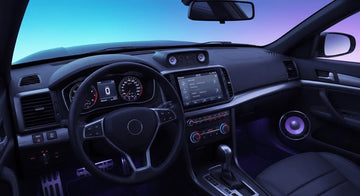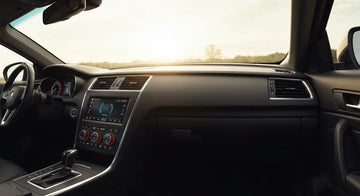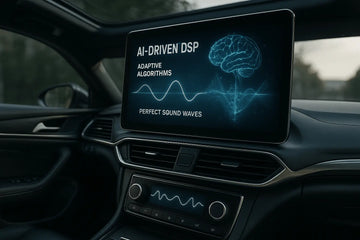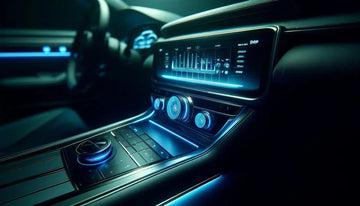Key Highlights
-
A Digital Signal Processor (DSP) is a powerful tool that gives you total control over the sound quality in your car audio system.
-
Mastering DSP settings allows for precise tuning of your system's frequency response for unparalleled clarity and depth.
-
Digital signal processing corrects acoustic imbalances inside your vehicle, greatly improving the overall audio experience.
-
Key settings like time alignment, equalization, and crossovers are crucial for achieving a truly immersive sound.
-
Proper DSP tuning improves bass, enhances vocal clarity, and creates an accurate soundstage.
Introduction
Transforming your car's sound from a standard factory system to an audiophile's dream is entirely possible. The key to unlocking this potential lies in understanding how to properly adjust your equipment. A Digital Signal Processor (DSP) is the single most impactful component for elevating your car audio system. By giving you precise control over every aspect of the audio signal, a DSP allows you to customize your sound quality for a truly exceptional audio experience every time you get behind the wheel.
Understanding Digital Signal Processing (DSP) in Car Audio Systems
Digital signal processing is a technology that digitally manipulates an audio signal before it reaches your speakers. In car audio, a DSP is a powerful tool that takes the output from your head unit and provides you with the controls to refine it. This process allows you to correct for the unique acoustic challenges of a vehicle's interior.
By adjusting various frequency ranges and other parameters, you gain complete command over your audio system. This audio signal processing capability is what separates a mediocre setup from one that delivers outstanding sound quality. Let's look closer at how a DSP works and why it is so important.
What is a DSP and How Does It Work?
A DSP is essentially the brain of a modern car audio system. It's a specialized microprocessor that takes a digital audio signal and modifies it in real-time. It intercepts the signal from your source unit (like a car stereo) before it goes to the amplifier and speakers, allowing you to make surgical adjustments.
The device works by converting the analog audio signal to digital, applying your desired changes, and then converting it back to an analog signal to be amplified. This digital manipulation lets you control elements like equalization (EQ), time alignment, and crossovers with incredible precision. You can shape the sound to fit your exact preferences and overcome the limitations of your car's cabin.
The best practice for tuning your car DSP is to start with a flat frequency response and make small, incremental changes. Use a high-quality microphone and Real-Time Analyzer (RTA) software to measure the sound, which helps you make informed adjustments for a balanced and clear sound system.
Key Benefits of Using DSP for Sound Quality
Integrating a DSP into your car's audio system offers a dramatic improvement in sound quality. It empowers you to tailor the listening experience to your exact tastes and correct for acoustic issues that are unavoidable in a vehicle. The level of control you gain is simply not possible with a factory stereo alone.
To optimize a DSP for overall sound quality, you need to use its features to correct for the car's environment. The primary benefits come from being able to make precise adjustments that create a cohesive and immersive sound field. These benefits include:
-
Improved Frequency Response: You can boost or cut specific frequencies to match your music or personal taste.
-
Enhanced Stereo Imaging: Time alignment ensures sound from all speakers reaches you at the same time, creating a perfect stereo image.
-
Greater Clarity: By controlling crossovers and EQ, you can reduce distortion and ensure each speaker only produces the frequencies it’s designed for.
Ultimately, these capabilities work together to transform your audio system, allowing you to hear music with the clarity and depth the artist intended.
Why DSPs Matter for Car Audio Enthusiasts
For serious car audio enthusiasts, a factory sound system is just a starting point. The unique acoustic environment of a car, with its mix of hard and soft surfaces, creates reflections and sound absorption that can ruin an audio experience. This is where digital signal processors become essential tools for achieving the best sound quality.
A DSP gives you the power to become the sound engineer for your own vehicle. You can meticulously adjust specific frequency bands to bring out the details in your music, from the deepest bass notes to the crispest highs. This level of control is what allows you to craft a soundstage that feels wide and lifelike, as if you were at a live concert.
Virtually any car audio system can benefit from a DSP upgrade, from a basic factory setup to a high-end aftermarket one. Even with premium speakers and amplifiers, a DSP is necessary to correctly tune the system to the vehicle’s unique acoustics and unlock its true performance potential.
Crucial DSP Settings That Impact Sound Quality
Achieving exceptional sound quality is a process of careful DSP tuning. While a DSP offers many features, a few crucial settings have the most significant impact on your listening experience. Mastering these controls allows you to shape the frequency response and overall character of your car audio setup.
These settings are the foundation of a great-sounding system. By focusing on frequency adjustments, time alignment, and phase, you can address the most common audio problems in a car. Let's explore how to adjust these critical settings for the best results.
Frequency Range Adjustments for Clarity
Clarity is one of the most desired attributes in a car audio system, and it is primarily achieved by managing different frequency ranges. Your DSP allows you to fine-tune the audio signal by boosting or cutting specific frequencies, ensuring that no single range overpowers another. This balancing act is key to hearing every detail in your music.
To get the best audio clarity, the ideal frequency range to adjust on a car DSP is the midrange (250 Hz to 4 kHz). This is where vocals and most instruments reside. Small adjustments in these frequency bands can have a huge impact on how clear and present the music sounds. For example, a slight boost around 2-4 kHz can add brightness and detail.
Here are some key frequency bands to pay attention to for improved clarity:
-
Low-Midrange (200-500 Hz): Reducing this range slightly can remove "muddiness."
-
Midrange (500 Hz - 2 kHz): This is the core of vocals and instruments; adjust for presence.
-
Upper-Midrange (2 kHz - 4 kHz): Boost this area for enhanced clarity and definition.
-
Treble (4 kHz - 20 kHz): Small boosts can add sparkle, but too much can sound harsh.
Best DSP Settings to Enhance Bass and Vocals
Finding the perfect balance between impactful bass and crisp vocal clarity is a common goal in car audio tuning. A DSP makes this possible by allowing you to adjust the frequency response without one element compromising the other. You can create a sound profile that is both powerful and detailed.
To improve both bass and clarity, you need to use the equalizer and crossover settings strategically. For impactful bass, identify the sub-bass (20-60 Hz) and mid-bass (60-250 Hz) frequencies. A small boost in these areas can add weight and punch. At the same time, ensure your subwoofer's low-pass filter is set correctly so it doesn't play higher frequencies that can make the sound muddy.
For vocal clarity, focus on the midrange frequencies (around 250 Hz to 2 kHz). Often, cutting a small amount of the low-midrange (250-500 Hz) can clean up the sound, allowing vocals to shine through. By carefully managing these separate parts of the frequency spectrum, you can achieve excellent audio quality where both bass and vocals are strong and clear.
Optimizing Time Alignment and Phase Controls
Time alignment is one of the most powerful features of a DSP for creating a realistic soundstage. In a car, you are not seated equally distant from all the speakers. This means the sound from the closer speakers reaches your ears sooner than the sound from the farther ones. Time alignment digitally delays the audio signal to the closer speakers so that sound from every speaker arrives at your ears simultaneously.
This synchronization is critical for creating a focused stereo image. Without it, the sound can seem disjointed and pulled toward the nearest speaker. Making these precise adjustments with your DSP places the sonic image directly in front of you, as if the performers were on your dashboard.
Phase controls are also important, especially for subwoofers, as they ensure all speakers are moving in unison. Different DSP settings, particularly time alignment, directly affect vocal clarity by ensuring the frequencies that make up a voice arrive at your ear at the same moment. When perfectly aligned, the audio system produces a clearer, more focused, and natural-sounding vocal performance.
Equalization (EQ) Strategies with DSP
Equalization is the heart of DSP tuning. Using your DSP's equalizer, particularly a parametric EQ, you can make surgical equalization adjustments to the sound. Unlike basic bass and treble controls, a DSP lets you pinpoint exact frequencies and adjust them with precision. This is essential for tailoring the sound to your vehicle's acoustics and your personal listening preferences.
A well-thought-out EQ strategy can fix frequency response peaks and dips, remove harshness, and add warmth, transforming your car audio experience. The following sections will guide you through effective EQ strategies for balanced sound, powerful bass, and a natural audio profile.
Recommended EQ Settings for Balanced Sound
Achieving a balanced sound is the primary goal of car audio tuning for many listeners. This means no single part of the audio signal is overly emphasized, allowing you to hear your music as a cohesive whole. The key is to start with a flat EQ setting and make subtle adjustments across the frequency bands.
To set your DSP equalizer for a balanced sound, you should aim for a smooth frequency response. Use a reference track you know well and listen for any frequencies that sound too loud or too quiet. Use small cuts to tame harsh or boomy frequencies rather than large boosts, as cutting is often more effective and introduces less distortion.
A good starting point for a balanced EQ setting is to make small adjustments that complement each other. The goal is to create a musical and enjoyable sound, not a perfectly flat line on an analyzer. Here is a sample table of adjustments for a balanced profile.
|
Frequency Range |
Purpose |
Suggested Adjustment |
|---|---|---|
|
20-60 Hz |
Deep Bass/Sub-Bass |
+2 to +3 dB |
|
60-200 Hz |
Mid-Bass Punch |
+1 to +2 dB |
|
200-500 Hz |
Warmth/Body |
0 to -2 dB |
|
500 Hz – 2 kHz |
Vocal/Instrument Core |
0 dB (Flat) |
|
2 kHz – 4 kHz |
Clarity/Presence |
0 to +1 dB |
|
4 kHz – 20 kHz |
Brightness/Air |
+1 to +2 dB |
Achieving Maximum Bass Without Distortion
Everyone loves powerful bass, but it's easy to push your system too far and end up with distorted, "muddy" sound. A DSP gives you the tools to achieve maximum bass response while maintaining high audio quality. The secret is to use both the equalizer and crossover settings effectively.
The recommended EQ settings for maximum bass without distortion involve making narrow, targeted boosts to specific frequency bands in the sub-bass region (typically between 30-60 Hz). Instead of a broad boost across all low frequencies, use your parametric EQ to find the frequency where your subwoofer is most efficient and apply a moderate boost of +3 to +6 dB. This enhances the perceived bass without overwhelming the system.
It is also crucial to set your low-pass crossover correctly. Ensure your subwoofer is only playing low frequencies (usually below 80 Hz) and that your main speakers have a high-pass filter to block those same frequencies. This prevents your smaller speakers from trying to reproduce deep bass, which is a major cause of distortion and poor sound output.
Starting Points for a Natural Sound Profile
For audiophiles who want their music to sound as the artist intended, a natural sound profile is the ultimate goal. This profile avoids excessive boosts in the bass or treble and focuses on creating a smooth, balanced frequency response. Careful tuning is essential to achieve this level of accuracy in a car's challenging acoustic environment.
A good starting point for DSP settings for a natural sound profile is to set everything flat. Turn off all EQ boosts and set your time alignment and levels based on measurements. From there, your first adjustments should be cuts, not boosts. Use an RTA to identify significant peaks in the frequency response caused by your car's interior and use the parametric EQ to gently reduce them.
The goal is to correct for the acoustic problems in your audio setup, not to artificially color the sound. Small, precise cuts to problematic frequencies will do more to improve the overall sound quality than large boosts will. This patient approach results in a transparent and natural sound profile that is detailed and non-fatiguing to listen to for long periods.
Tuning Your DSP for Superior Performance
The DSP tuning process is where you truly unlock your system's potential. Following best practices ensures you get the most out of your investment and achieve superior system performance. This involves more than just turning knobs; it requires a methodical approach to measuring, listening, and adjusting.
Whether you are a beginner or a seasoned car audio enthusiast, understanding the right steps can make a huge difference in the final audio quality. We will cover whether to use presets or custom settings, how to tune the system yourself, and which features will give you the best soundstage.
Custom vs. Preset DSP Settings: Which Is Better?
Many DSPs come with preset DSP settings for different music genres like "Rock," "Pop," or "Jazz." These can be a convenient starting point, but they are not optimized for your specific audio setup or vehicle. Presets are generic and cannot account for your unique speakers, their placement, or your car's interior acoustics.
For the best sound quality, custom DSP settings are always superior. A custom tune is tailored specifically to your equipment and your personal preferences. While it takes more time and effort, the result is a much more accurate and enjoyable audio experience. Custom tuning allows you to address the specific acoustic challenges of your car.
So, which is better?
-
Preset Settings: Good for beginners or for quickly getting sound from your system. They offer convenience but lack precision.
-
Custom Settings: Essential for achieving the best possible sound. They are tailored to your car, your gear, and your ears.
-
The Verdict: While presets are useful, investing time in a custom tune will unlock the true potential of your audio system.
Step-by-Step Guide to Tuning DSP Yourself
Tuning a DSP yourself can be a rewarding process that gives you complete control over your sound system. With the right tools and a systematic approach, you can achieve professional-level results. The best practices for car audio tuning focus on structure and making one change at a time.
First, you'll need a calibrated measurement microphone and Real-Time Analyzer (RTA) software. This equipment allows you to see the frequency response of your system, taking the guesswork out of audio signal processing. Start with all EQ settings flat and crossovers disabled.
Here is a basic step-by-step guide to get you started on your DSP tuning journey:
-
Set Levels and Gains: Properly set the gain on your amplifiers to ensure you have a clean signal without clipping.
-
Set Crossovers: Configure the high-pass and low-pass filters for each speaker to ensure they only play frequencies they can handle.
-
Time Align: Measure the distance from each speaker to the listening position and enter the values into your DSP to set the delays.
-
Equalize: Use the RTA and your ears to make small EQ adjustments to smooth out the frequency response.
DSP Features That Improve Soundstage and Imaging
A great car audio system does more than just play music loudly; it creates a believable soundstage and precise imaging. Soundstage refers to the perceived width, depth, and height of the music, while imaging is the ability to pinpoint the location of individual instruments and vocals within that stage. A DSP is essential for achieving this superior audio experience.
To improve the soundstage in your car audio system, the single most important DSP feature to focus on is time alignment. By delaying the signal to the speakers closest to you, time alignment ensures that sound from every speaker arrives at your ears at the exact same time. This synchronization is what creates a stable, centered, and realistic stereo image.
Other crucial features include level matching and equalization. You must ensure the volume of each speaker is correctly balanced at the listening position. Proper EQ also plays a role, as a smooth frequency response contributes to accurate sound reproduction. When these features are tuned correctly, your car audio system can recreate a magical three-dimensional performance right in front of you.
Conclusion
In conclusion, mastering the best DSP settings is essential for achieving superior sound quality in your car audio system. By understanding how Digital Signal Processing works and applying the correct frequency adjustments, equalization strategies, and tuning methods, you can transform your listening experience. Prioritizing these settings not only enhances clarity but also balances bass and vocals, ensuring that every note resonates perfectly. Don't underestimate the impact a well-tuned DSP can have on your audio performance. If you're ready to take your car audio to the next level, explore our expert consultations to discover tailored solutions for your specific needs.
Frequently Asked Questions
How do DSP settings affect vocal clarity in car audio?
DSP settings dramatically improve vocal clarity by allowing precise control over the audio signal. Using the equalizer to adjust midrange frequencies (250 Hz to 4 kHz) where vocals reside, and applying time alignment, ensures all parts of the voice arrive at your ear simultaneously. This focused DSP tuning leads to superior sound quality.
What’s the ideal frequency range to adjust on a car DSP for best audio clarity?
For the best audio clarity in car audio, the ideal frequency range to adjust is the midrange, specifically between 500 Hz and 4 kHz. This part of the frequency response contains most vocal and instrumental details. Small, precise adjustments to this audio signal can significantly improve clarity for the best sound quality.
Can any car audio system benefit from DSP upgrades?
Yes, absolutely any car audio system, from a factory setup to a fully custom one, can benefit from a digital signal processor. A DSP allows you to correct for the vehicle's poor acoustics and fine-tune the system performance, dramatically improving the overall audio experience and unlocking the true sound quality potential of your components.




